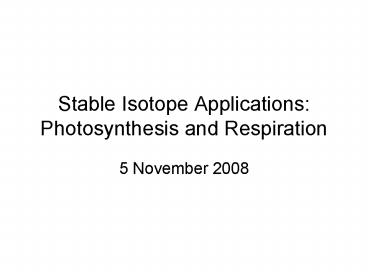Stable Isotope Applications: Photosynthesis and Respiration - PowerPoint PPT Presentation
1 / 30
Title:
Stable Isotope Applications: Photosynthesis and Respiration
Description:
Carbon isotopes and the global carbon cycle. Carbon isotope ... This is why d13C DIC is lower below the photic zone and lowest where respiration is highest ... – PowerPoint PPT presentation
Number of Views:354
Avg rating:3.0/5.0
Title: Stable Isotope Applications: Photosynthesis and Respiration
1
Stable Isotope ApplicationsPhotosynthesis and
Respiration
- 5 November 2008
2
Outline
- Carbon isotopes and the global carbon cycle
- Carbon isotope fractionation during
photosynthesis - Oxygen isotopes of dissolved oxygen in the ocean
- Oxygen isotope fractionation during respiration
3
Goal
- Understand what processes influence the isotopic
trends of DIC and dissolved O2 in the ocean - Carbon isotopes are fractionated during
photosynthesis (essentially no fractionation
during respiration) - Oxygen (O2) isotopes are fractionated during
respiration, (essentially no fractionation during
photosynthesis)
4
Introduction Carbon Cycle
Carbon isotopes have been very heavily
utilized to study various aspects of the earths
carbon cycle Extremely diverse
applications -Global, regional and local
scales -Ocean, atmosphere, terrestrial
environments -Current, historic, geologic time
scales Many applications are associated with
fractionation during photosynthesis
5
6
Earths Carbon Cycle
Rocks 20x106
7
(No Transcript)
8
Size and d13C (vs PDB) of Earths Carbon
Reservoirs
Rocks (carbonate) 0 Rocks (organic) ? -25
Volcanic CO2 -5
9
d13C in the Carbonate Rock Record
10
Carbon isotope fractionation during
photosynthesis (marine)
- Two step process both fractionate
- Diffusion across cell membrane
- CO2(aq) external to CO2(aq) internal
- Epsilon -1
- Carboxylation (carbon fixation)
- CO2(aq) internal
- Epsilon -30
- Relative to CO2(aq) internal
- Why is the average composition of marine organic
matter -22 ? - Overall fractionation effect is the result of
differences in the relative rates of these two
processes
11
Photosynthetic Pathways for C3 and C4 Plants
C3 Plants
C4 Plants
12
Two Step Photosynthesis Model in a Leaf
Step 1
Step 2
CO2
CO2aq
CO2ext
CO2int
C6H12O6
Inside Leaf
Air
13
Variations in d13C of Plankton
14
Dependence of d13C on CO2aq
15
Plankton d13C dependence on Growth Rate
Growth Rate
E
16
(No Transcript)
17
L. Washington DIC and d13C
18
d13C of Atmospheric CO2
19
d13C Change in Surface Ocean
11
20
(No Transcript)
21
O2 Cycle
Important Processes -photosynthesis,
respiration -air-water gas exchange, mixing,
circulation Photosynthesis CO2 2H2O light ?
CH2O O2 Respiration H2O O2 CH2O ? CO2
2H2O
22
Evaporation / Condensation
CO2 solubility
Carbonate equilibria
Photosynthesis
Respiration
CaCO3 precipitation
Methane formation
Evaporation / Precipitation
O2 solubility
Photosynthesis
Respiration
Solubility
Nitrogen Fixation
NO3- uptake by photosynthesis
Denitrification
23
KIE during Respiration
24
(No Transcript)
25
Depth Trends in d18O-O2and O2sat at ALOHA
26
(No Transcript)
27
d18O-O2 in Amazon Lakes and Rivers
Lakes squares Amazon R. circles
Tributaries triangles
28
Summary Carbon
- Ratio of organic carbon burial to carbonate rock
deposition determines the isotopic composition of
different reservoirs on geologic timescales - C isotopes are fractionated during photosynthesis
- The dominant influence is a kinetic fractionation
which depletes the organic product (CH2O)
relative to the source DIC - THIS EFFECT ISOTOPICALLY ENRICHES (makes the
delta value more positive) THE SURFACE OCEAN DIC - Magnitude of fractionation is a function of the
relative rate of diffusion across the cell
membrane versus the enzymatic uptake rate of CO2
in the cell - d13C of plankton (organic material) ranges from
-16 to -35 (average is -22 reflecting a
overall fractionation of -15 relative to CO2
aq) - Very little fractionation during respiration (BUT
REMINERALIZATION OF LIGHT (d13C -22 delta
value) ORGANIC C TO DIC INFLUENCES THE ISOTOPIC
COMPOSITION OF DIC BELOW THE SURFACE OCEAN) - This is why d13C DIC is lower below the photic
zone and lowest where respiration is highest - Useful as a tracer of export production
29
Summary Oxygen (O2)
- O2 is fractionated by respiration
- O2 isotopic composition evolved from
photosynthesis reflects source water (d18O of O2
is -23 relative to air) - O2 of air is the standard for O2 gas (23
relative to SMOW) - THIS IS A POINT OF CONFUSION since SMOW is widely
used in paleo applications - In the surface ocean gas exchange dominates (i.e.
isotopic composition is near d18O 0.7 relative
to air or slightly below depending on the
influence of photosynthetic O2) - RESPIRATION FRACTIONATES O2 (a 0.980 e - 20
) isotopically ENRICHING the remaining pool of
O2 in the heavy isotope 18O - Respiration signal dominates below the surface
ocean with increasing isotopic enrichment of the
remaining O2 pool as O2 is used up and converted
to water during respiration (i.e. the respirating
organisms preferentially use 16O, enriching the
remaining pool of O2 in 18O) - Essentially no fractionation during
photosynthesis (BUT photosynthetically evolved O2
has a d18O of -23 which is depleted relative to
O2 in equilibrium with the atmosphere 0.7 ) - Can be applied as a tracer of respiration,
although somewhat problematic
30
Exam
- I will post equations you need to know today
- Also, I will post PS 5 solutions and this PPT
- Questions






























